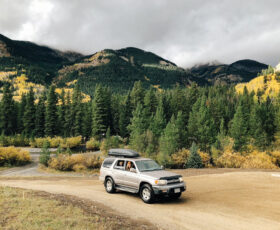Last Updated on 4 months
Master the Art of Switching to Winter Tires at the Right Time
As winter approaches, ensuring your vehicle’s best possible safety and performance is a top priority. One essential aspect of this preparation is knowing when to change to winter tires. By switching to winter tires at the right time, you’ll benefit from improved traction, control, and overall safety in cold weather conditions. This guide outlines the top five tips to help you determine the optimal time to switch to winter tires so you can stay safe on the road throughout the season.
Key Takeaways
- Change to winter tires when temperatures consistently fall below 45°F for optimal performance and safety.
- Thanks to specialized rubber compounds and deep treads, Winter tires provide enhanced traction and control in cold conditions.
- Ensure your tires meet local winter regulations and are installed promptly to avoid fines.
- Monitor your tire’s tread depth and replace it when it reaches 6/32 inch or 4.8 millimeters.
- Stay informed about upcoming weather patterns to make the switch at the right time ahead of hazardous conditions.
Understanding the Importance of Winter Tires for Seasonal Safety
The benefits of winter tires cannot be overstated, as they play a critical role in ensuring driver safety during the chilly months. Unlike all-season tires that stiffen and lose traction as the temperature plummets, winter tires maintain flexibility and grip, largely thanks to their special rubber compounds. Furthermore, their deep treads and sipes empower them with greater stopping power and enhanced control, even in the harshest winter driving conditions. Investing in winter tires will substantially improve your odds of safe and uneventful seasonal travels.
- Stay Softer and More Flexible Throughout Winter
- Equipped with Deep Treads and Sipes
- Increased Stopping Power and Control
- Higher Level of Security on Icy Roads
Some regions have even legislated the use of winter tires, with potential fines for noncompliant drivers serving as a testament to the importance of these specialized products for seasonal road safety. With winter tires in place, you’ll be considerably better prepared for extreme cold, ice, and snow driving risks.
“Winter tires mitigate risks associated with driving in extreme cold, ice, and snow by staying softer and more flexible in low temperatures, unlike all-season tires that harden and lose grip.”
In addition to these benefits, proper winter tire maintenance further bolsters their effectiveness. Regularly inspecting your tires, checking for potential issues like worn treads or air pressure imbalances, and promptly taking corrective action can help ensure your winter tires’ optimal performance and longevity.
| Winter Tire Safety Tips | Recommendations |
|---|---|
| Inspect Tires Regularly | Check for tread wear, proper inflation, and any visible damage. |
| Rotate Tires | Rotate your winter tires according to the manufacturer’s recommendations to promote even wear across all four tires. |
| Store Tires Properly | Store your winter tires in a cool, dry place away from direct sunlight and heat sources to preserve their condition when unused. |
By understanding the importance of winter tires and following essential safety and maintenance tips, you’ll be well-equipped to face the challenges of winter driving, ensuring safety and peace of mind for you and your loved ones, no matter what weather conditions come your way.
Recognizing the Right Temperature for Winter Tire Installation
Knowing when to change to winter tires and schedule a winter tire installation for safe driving when temperatures drop. To ensure maximum performance and safety, it is vital to understand the relationship between tire performance and external temperatures.
Why Temperature Influences Tire Performance
Regular tire rubber compounds in all-season and summer tires harden in cold temperatures. This hardening significantly reduces traction, making driving dangerous while switching to winter tires. When temperatures consistently fall below 45°F, it is time to consider changing winter tires from a special rubber compound designed to remain pliable even in the cold. This flexibility allows winter tires to maintain grip, providing better control and performance on icy roads.
Monitoring Weather Patterns for Optimal Tire Change Times
Keeping an eye on weather forecasts is crucial for timing your change to winter tires. Weather forecasts typically indicate upcoming snow or freezing rain, allowing you to schedule your winter tire installation before these hazardous conditions occur. Changing to winter tires just as the temperature begins to plummet can elevate road safety and maintain better control during winter.
Closely monitoring weather forecasts and recognizing when temperatures consistently fall below 45°F will help you determine the optimal time to change to winter tires.
As drivers, it’s crucial to schedule the winter tire installation when needed to prevent any accidents or breakdowns caused by improper tires during freezing weather.
- Monitor the weather forecasts regularly.
- Check other sources, such as weather apps and news channels, for consistency in predictions.
- Make a note of when average temperatures consistently dip below 45°F.
- Call a tire shop and schedule your winter tire change immediately.
- Drive confidently in the knowledge that your tires are suited to winter conditions.
By paying close attention to the temperature drops and staying informed about upcoming weather patterns, you’ll be well-prepared to tackle winter roads with the right tires that offer optimal performance and safety.
Assessing Tread Depth and Tire Condition

Proper winter tire maintenance is crucial for ensuring safety on the road during the colder months. One of the most important winter tire safety tips is regularly checking your tires’ tread depth and overall condition. Adequate tread depth is essential for sufficient traction in snow and ice, contributing to vehicle stability and safety.
Experts recommend that winter tires have a minimum tread depth of 6/32 inch (4.8 millimeters) for optimal performance. Regular tire condition monitoring, including tread wear, can help determine when to change to new winter tires.
Remember: Regular tire inspections are key to maintaining optimal winter driving safety.
- Inspect Tires Visually: Look for visible damage, such as cuts, cracks, or punctures. Damaged tires can compromise your safety on the road.
- Check Tread Depth: Use a tread depth gauge to measure the depth of your winter tires accurately. You can use the popular “penny test” as a quick alternative to gauge your tread depth.
- Monitor Uneven Wear: Ensure your tires wear evenly across the entire surface. Uneven wear could indicate a need for tire rotation, alignment, or replacement.
Understanding the condition of your winter tires also involves checking for any signs of dry rot or tire aging. Aged tires can become unsafe, even with adequate tread depth, due to the rubber losing flexibility and effectiveness in extreme temperatures.
Maintaining optimal tire condition and prioritizing regular winter tire maintenance will greatly enhance your safety during winter. Stay vigilant and monitor the condition of your tires to ensure a safe and smooth driving experience.
Preparing for Seasonal Weather Shifts: The Proactive Approach

Adopting a proactive mindset is crucial when preparing for winter driving as winter approaches. By planning your winter tire installation ahead of time, you can avoid the risks associated with last-minute tire changes in potentially dangerous conditions. Proper planning ensures your vehicle’s safety and readiness in the face of sudden changes in road conditions.
Planning for Sudden Changes in Road Conditions
Keeping an eye on local weather forecasts is essential for gauging when to undertake a proactive winter tire change. This enables you to make well-timed decisions and schedule your tire installation before icy or snowy weather, ensuring a safe and comfortable driving experience.
“Failing to prepare is preparing to fail.” – Benjamin Franklin
- Monitor your local weather forecast regularly for signs of dropping temperatures and impending snowfall.
- Schedule your winter tire installation appointment well in advance to avoid last-minute stress.
- Ensure your vehicle is prepared for winter, including antifreeze levels, wiper blades, and battery health.
Furthermore, it is essential to equip yourself with a basic understanding of your local area’s winter driving regulations and guidelines. This knowledge will help you better prepare your vehicle and yourself for the challenges of winter driving:
| State | Winter Tire Requirements |
|---|---|
| Colorado | Winter tires or chains are required for certain highways in the winter months, such as I-70. |
| California | Winter tires or chain controls are required during certain conditions on mountain roads. |
| New York | There are no specific winter tire regulations, but heavy fines for obstructing traffic due to inadequate tires. |
By adopting a proactive approach to winter tire installation and preparing for winter driving, you can enjoy a safer, more comfortable journey on the road during the colder months. Start planning early and equip your vehicle with the right winter tires, ensuring safety and peace of mind in challenging conditions.
Factors to Consider When Choosing Winter Tires
When it’s time to change to winter tires, factors such as tire size, performance category, vehicle manufacturer’s recommendations, and driving needs are crucial in making an informed decision. Thorough research and consideration of the best winter tire brands enhance safety and driving comfort during the cold months. This section will discuss how to choose winter tires, explore winter tire buying guides, and examine winter tire reviews to help you find the perfect set for your vehicle.
Before purchasing winter tires, verify the tire size and performance category that best aligns with your vehicle specifications and winter driving needs. One notable feature to look for is the three-peak mountain snowflake symbol on a tire’s sidewall, indicating that the tire is rated for severe snow conditions. Keeping an eye out for this symbol ensures optimal safety, traction, and control throughout the frosty months.
Several reputable brands offer quality winter tires with varying characteristics, catering to different vehicle types and driving habits. For example, Firestone Winterforce tires are well-suited for trucks, while Bridgestone Blizzak tires excel in all-around performance for most vehicles. Reading through winter tire reviews and consulting buying guides can greatly assist in identifying a good fit for your specific needs.
For drivers who prefer the convenience of year-round tires without compromising winter performance, all-weather options such as Firestone WeatherGrip may be a practical choice. These tires can easily tackle summer and winter conditions, providing a versatile alternative to frequent tire changes. Considering all these factors, you can confidently select the best winter tires for your vehicle, ensuring a safe and smooth driving experience throughout the colder months.
FAQ
When should I change to winter tires?
The optimal time to switch to winter tires is when temperatures consistently fall below 45°F. Regular tires lose traction as rubber compounds harden in colder weather, whereas winter tires are designed with specialized rubber to stay flexible and provide better grip.
What are the benefits of using winter tires?
Winter tires offer improved safety, superior traction, better stopping power, enhanced grip on hills, and better maneuverability in cold, snowy, and icy conditions. Their specialized design features deep treads and sipes that help channel snow and slush, ensuring a safer driving experience during the winter months.
How do I choose the right winter tires for my vehicle?
To choose the right winter tires, consider tire size, performance category, vehicle manufacturer recommendations, and your driving needs. Look for the three-peak mountain snowflake symbol, which indicates tires suitable for severe snow conditions. Some popular options include Firestone Winterforce for trucks and Bridgestone Blizzak for all-around performance.
How do I know when to replace my winter tires?
Regular checks for tread depth are crucial, as adequate traction is needed to ensure vehicle stability and safety. Consider changing your winter tires when the tread depth reaches 6/32 inches or 4.8 millimeters.
Can I use all-season tires during winter instead of switching to winter tires?
All-season tires are not specifically designed for winter and tend to harden and lose grip in cold temperatures. For optimal safety and handling during winter, it is highly recommended to switch to winter tires. However, all-weather tires like Firestone WeatherGrip offer seasonal flexibility without frequent tire changes.
Source Links









